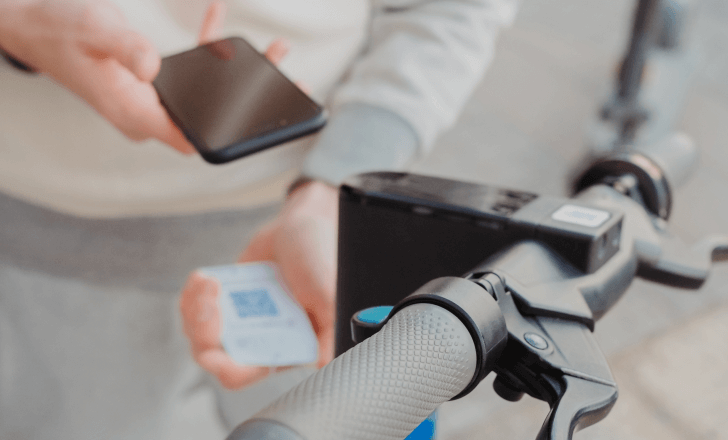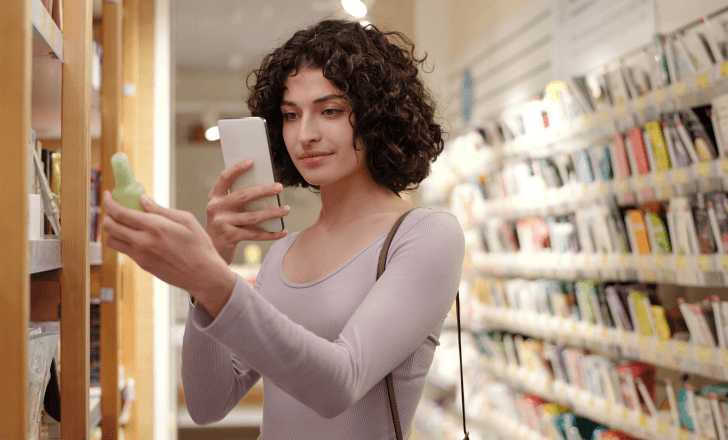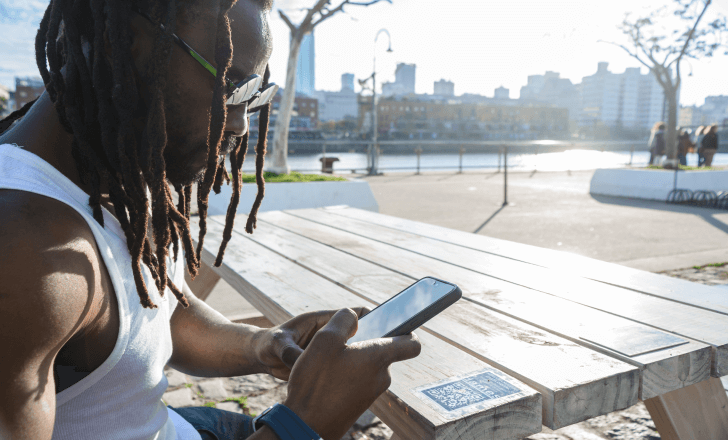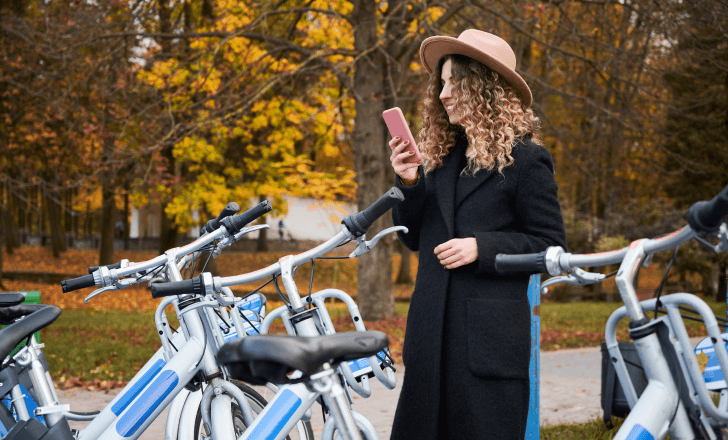QR codes have become an integral part of our digital interactions, from accessing restaurant menus to making online payments. However, the widespread use of QR codes has also raised concerns about their safety. The potential for hackers to create malicious QR codes that lead users to fake websites, capture personal data, or even track their geolocation highlights the importance of being aware of these scams to protect privacy and sensitive data.
Additionally, using secure QR codes that require a password for accessing sensitive information like financial details or medical records is crucial for keeping it safe and secure. It is also essential to use a reputable QR code generator to avoid security threats and ensure data safety for users. This comprehensive guide will explore the risks associated with QR codes, how to identify safe QR codes, where not to use them, and whether you can trust them.
What are the risks of QR codes?
1. Malicious QR codes
Malicious QR codes can direct users to fraudulent websites designed to steal sensitive data. Fake QR codes can lead to phishing websites or medical fraud, posing significant safety concerns. Scanning such codes may lead to the download of malicious software or the exposure of personal information.
2. Phishing scams
Cybercriminals use QR codes to launch phishing attacks. By embedding a malicious URL within a QR code, they can trick users into entering their login credentials or credit card details on fake websites. Are QR codes safe from phishing? Vigilance is crucial to avoid falling victim to these scams.
3. Data theft
Are QR codes safe for personal data? Scanning a QR code can pose significant risks, especially if the QR code is malicious. QR codes can be used to steal sensitive data from mobile devices. When a user scans a malicious QR code, it might trigger the download of malware that collects information such as phone numbers, contact details, and even financial data.
4. Unsecure websites
Some QR codes may lead to websites that are not secure and lack proper encryption. This can expose users to various security threats, including data breaches and identity theft. Are QR codes safe to use on unsecured sites? Always check the security of the destination website.

How do I know if a QR code is safe?
1. Verify the source
Are QR codes safe when they come from a trusted source? Always ensure the QR code comes from a trusted source. Avoid scanning codes from unsolicited emails, unfamiliar websites, or unknown physical locations.
2. Use a QR scanner with security features
Use QR scanner apps that include security features to detect malicious QR codes. The increased usage of QR code scans during the coronavirus pandemic for contact tracing and contactless access to information has highlighted the importance of secure scanning. These apps can alert you if the code directs you to a potentially dangerous website. Are QR codes safe with the right scanner? Using security-enhanced scanners can significantly reduce risks.
3. Check the URL
Before proceeding, check the URL that the QR code directs you to. Are QR codes safe if the URL is secure? Look for signs of legitimacy, such as the presence of “https” in the web address, which indicates a secure connection.
4. Avoid shortened URLs
Be cautious of QR codes that use URL shortening services. These can obscure the final destination, making it harder to verify the safety of the link. Are QR codes safe if the URL is visible? Transparency in the URL helps ensure safety.

Where should you not use QR codes?
1. Untrusted locations
Are QR codes safe in public or untrusted locations? Avoid scanning QR codes in places like public transport or random flyers. These are common places for cybercriminals to place malicious codes.
2. Emails from unknown senders
Do not scan QR codes in emails from unknown senders. Are QR codes safe in unsolicited emails? These are often used in phishing attacks to direct users to malicious websites.
3. Unverified websites
Are QR codes safe on unverified websites? Ensure the website is legitimate before scanning any codes it provides. Avoid scanning QR codes from unverified or suspicious sites.

Can I trust a QR code?
Are QR codes safe to trust? Trusting a QR code depends on several factors. Always ensure that the QR code is from a reliable source and use security-enhanced QR scanner apps. By being cautious and aware of potential risks, you can significantly reduce the chances of falling victim to malicious QR codes.
Additional information on QR codes
Types of QR Codes
1. Static QR codes
Are QR codes safe when static? Static QR codes contain fixed information that cannot be changed once created. They contain ingrained data and are suitable for fixed data such as network passwords or serial numbers. They are commonly used for simple tasks like linking to a website or sharing contact details.
2. Dynamic QR codes
Are QR codes safe when dynamic? A dynamic QR code allow the information within the code to be edited without changing the actual code. This flexibility makes them suitable for marketing campaigns and trackable interactions. However, they require access to the user account to manage the content changes.
Additionally, there is a potential risk for cybercriminals to create malicious QR codes to deceive people into accessing harmful content.
Common uses of QR codes
1. Restaurant menus
Are QR codes safe for menus? QR codes have become increasingly popular in restaurants for accessing digital menus, significantly reducing the need for physical menus and promoting contactless interactions.
By scanning a QR code with their mobile devices, patrons can view the restaurant’s menu directly on their screens, minimizing physical contact and helping maintain hygiene standards. Moreover, digital menus can be easily updated with new items or specials without the need for reprinting, providing a cost-effective solution for restaurant owners. However, it’s essential to ensure that these QR codes are safe and lead to legitimate menus to prevent any potential misuse or data theft.
2. Mobile payments
Are QR codes safe for payments? Many modern payment systems now utilize QR codes for quick and secure transactions, allowing users to scan a code to make a payment directly from their mobile devices. This method is particularly popular in regions with widespread mobile payment adoption, such as China and India.
Users can simply scan the QR code displayed by the merchant, enter the payment amount, and authorize the transaction, making the process swift and convenient. To enhance security, it’s crucial that the QR codes are generated by reputable payment platforms and that users verify the authenticity of the code before completing the transaction. Encryption and secure connections (https) also play a vital role in ensuring that the payment data is protected.
3. Event ticketing
Are QR codes safe for ticketing? QR codes are extensively used in event ticketing to provide a paperless and efficient way to manage entry, significantly reducing the risk of ticket fraud. Event organizers can issue digital tickets containing QR codes, which attendees can present on their mobile devices for scanning at the venue entrance.
This system not only streamlines the check-in process but also helps prevent counterfeit tickets, as each QR code can be uniquely generated and linked to a specific attendee. Additionally, QR codes for event ticketing can be integrated with other digital services, such as reminders and updates about the event, enhancing the overall attendee experience. To maintain security, it’s important that these QR codes are generated and managed by trusted ticketing platforms to ensure their validity and prevent unauthorized access.
4. Product packaging
Are QR codes safe on product packaging? Many companies now include QR codes on product packaging to provide customers with additional information, such as usage instructions, nutritional details, or promotional offers.
By scanning the QR code, consumers can access detailed product information that may not fit on the packaging itself. This interactive element not only enhances customer engagement but also allows brands to deliver up-to-date content without altering the physical packaging. Ensuring the safety of these QR codes involves verifying that they lead to secure, official websites or applications, preventing any risk of redirecting to malicious sites.
5. Marketing and advertising
Are QR codes safe for marketing and advertising? QR codes are widely used in marketing campaigns to direct potential customers to promotional content, special offers, or social media pages. Marketers can track the effectiveness of their campaigns by analyzing the scan data, such as location and frequency.
By embedding QR codes in posters, flyers, and digital ads, businesses can create interactive experiences that drive engagement and conversions. For safety, it’s crucial that the QR codes are generated by reputable marketing tools and lead to secure destinations, ensuring that users’ interactions are protected from phishing and other online threats.

How QR codes work
Are QR codes safe in their functionality? QR codes, short for Quick Response codes, function by encoding data into a pattern of black and white squares. These squares can then be decoded by a QR code scanner or smartphone camera to interpret digital information such as text, website URLs, or other data types. They can hold a variety of data types, including numeric, alphanumeric, and binary, making them versatile for different applications.
Data modes in QR codes
1. Numeric mode
Are QR codes safe in numeric mode? Numeric mode encodes numbers and is the most efficient in terms of storage capacity, allowing up to 7,089 characters to be stored in a single QR code. This mode is particularly useful for encoding numeric-only information, such as identification numbers, telephone numbers, and financial data like bank account numbers. The efficiency of numeric mode ensures that the QR code remains compact and easy to scan, even with large amounts of data. To ensure safety, it’s essential that QR codes containing sensitive numeric data are generated and managed securely, preventing unauthorized access or manipulation.
2. Alphanumeric mode
Are QR codes safe in alphanumeric mode? Alphanumeric mode encodes numbers and uppercase letters, including a few special characters like spaces and symbols, allowing for up to 4,296 characters to be stored. This mode is versatile and widely used for encoding URLs, product codes, and textual information that includes both letters and numbers.
The inclusion of special characters increases the flexibility of data that can be stored. For instance, alphanumeric mode can be used to create QR codes for web addresses, which often contain a mix of letters, numbers, and special characters. To maintain security, it’s important to verify the source of the QR code and ensure it directs to a legitimate and secure destination.
3. Byte mode
Are QR codes safe in byte mode? Byte mode encodes data in binary form, supporting various character sets for different languages, allowing up to 2,953 characters to be stored. This mode is highly flexible and can encode any character from the ISO-8859-1 character set, making it suitable for encoding information in multiple languages.
Byte mode is often used for more complex data, such as multimedia files or application data, which requires encoding a diverse range of characters. Ensuring the safety of QR codes in byte mode involves encrypting the data and using secure channels for generating and scanning the codes, thus protecting the encoded information from potential cyber threats.
4. Kanji mode
Are QR codes safe for Kanji? Kanji mode is used for encoding Kanji characters, typically used in Japanese, allowing up to 1,817 characters to be stored. This mode is specifically designed to handle the unique character set of the Japanese language, making it highly efficient for encoding Kanji, Kana, and other double-byte characters.
It is particularly useful for businesses and applications targeting Japanese-speaking users. To ensure the safety of QR codes in Kanji mode, it’s crucial to use reputable QR code generators and scanners that support Kanji encoding and to verify the legitimacy of the encoded information before scanning.

Advanced features
1. Extended channel interpretation (ECI)
Are QR codes safe with ECI? ECI allows QR codes to specify additional character sets beyond the default, enabling the encoding of complex data.
2. Structured append mode
Are QR codes safe in structured append mode? This feature allows multiple QR codes to be combined to store more data than a single QR code can hold.
Best practices for creating QR codes
1. Use reliable QR code generators
Are QR codes safe when created with reliable generators? It is crucial to create QR codes safely by following best practices and using secure methods. For instance, a static QR code contains ingrained data and is suitable for fixed information like network passwords or serial numbers. Choose reputable QR code generators to ensure the codes you create are secure and functional.
2. Enable tracking
Are QR codes safe with tracking? For marketing purposes, use dynamic QR codes with tracking features to monitor the effectiveness of your campaigns.
3. Add branding
Are QR codes safe with branding? Incorporate your brand logo and colors into your QR codes to make them easily recognizable and trustworthy to your audience.
4. Test before deployment
Are QR codes safe when tested? Always test QR codes before widely distributing them to ensure they work correctly and lead to the intended destination.
Securing your QR codes
1. Password protection
Are QR codes safe with password protection? For sensitive information, consider using QR codes with password protection to prevent unauthorized access. Secure QR codes are essential for storing both public and private information, requiring a password to access sensitive details like financial or medical records.
2. Encryption
Are QR codes safe when encrypted? Encrypt the data within your QR codes to add an extra layer of security, especially for financial or personally identifiable information.
3. Regular updates
Are QR codes safe with regular updates? For dynamic QR codes, regularly update the content and monitor for any signs of misuse or tampering.

The future of QR codes
Are QR codes safe in the future? With advancements in technology, QR codes continue to evolve. Innovations such as QR memories (storing more complex data) and improved security measures are making QR codes more robust and versatile. As their use expands, staying informed about best practices and potential risks will be crucial in ensuring safe interactions with QR codes.
How do QR companies uphold user security?
If you’re thinking of using QR codes to run your business more effectively, you’ll also need to provide strong security and privacy measures for your organization and clients.
A good QR code generator with a solid reputation and long history takes this into account – QRcodeKit.com, for example, uses the following protocols to keep any scanner’s data safe:

A detailed anti-cybercrime system
QR Code KIT uses a specialized system to detect harmful attacks, passive and active. Their security settings are in line with global, state-of-the-art corporate standards as well as governmental regulations.
They also have the support of several cybersecurity services such as PhishLabs, Phishing Protection API by Google, and Amazon Security Team, which help their team swiftly find and terminate malicious activities in the form of phishing, spam, pharming, or cross-site scripting.
Bulletproof statistics security
It is a well-known fact that all QR code generators harness data collection techniques – while this can be used by businesses to serve their customers better, hackers can also mine it.
A good QR code generator will keep its data under lock and key. In QRcodeKit.com’s case, we standardize GDPR compliance – the European standard, which enforces the most secure data protection in the world, with harsh penalties to deter any potential wrongdoer.
Transparency with data tracking
It’s also essential to establish a clear and transparent idea of the information that a generator’s QR codes will track. QR Code KIT is known to keep things straightforward on our webpage – listing the following tracking variables:
- When they were scanned.
- Where they were scanned.
- How many times they were scanned.
- What type of operating system scanned them.
- Age and gender of individuals who’ve scanned them (Only if your Google Privacy Settings are set to public, which you can change.)
As businesses rely more and more on data analytics, it’s important to never sacrifice customer safety for the sake of potentially profitable insights.
A 24/7 cybersecurity support team
Malicious elements on the internet don’t take days off. So, if you’ve ended up compromising your data or facing any other issue, you need to work as quickly as possible for the sake of damage control.
QR Code KIT offers a 24/7 support team trained to quickly respond and provide guidance to companies, governments, institutions, or individuals that report suspicious activity – if you end up in a digital security crisis, you need someone useful in your corner.
A robust backup system
In emergencies, such as a data breach, a QR code provider needs to maintain a foolproof system of backups.
In QR Code KIT’s case, this is done through a server mirroring setup – paired alongside hourly backups for absolute reliability. If you do come across any malicious websites, make sure to send QRcodeKit.com a report following these suspicious QR activity report instructions.
Conclusion
Are QR codes safe to use? QR codes offer convenience and efficiency in various applications, from mobile payments to event ticketing. However, they also pose significant risks if not used cautiously. By understanding the potential dangers, verifying the source, and using secure QR scanner apps, you can safely navigate the digital landscape that heavily relies on QR codes. Stay informed, stay secure, and make the most of what QR codes have to offer.





